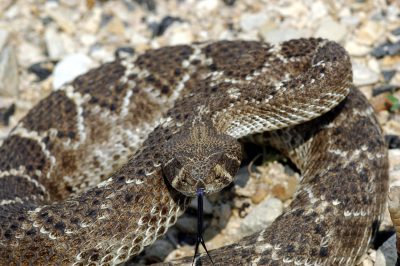
Diamondback Rattlesnake
Southern Arizona hosts only two snakes that are venomous. One is the coral snake which has red and black bands. The other is the rattlesnake. Each carries venom with hundreds of different proteins that have two basic effects.
One group of venom is hemo-toxic, effecting blood clotting. The other is neuro-toxic, effecting the nerves.
Symptoms that accompany neurotoxins include tingling of the lips, dizziness, vomiting and shock. If the venom is neurotoxic enough, these symptoms can progress into paralysis and difficulty in breathing which can cause death.
Though there have been no reported deaths from coral snakes in Arizona recently, their venom is weighted more towards the neurotoxins. The rattler, on the other hand, is weighted more towards the hemotoxins.
This means that rattlesnake bites are more likely to cause bruising and inflammation that facilitates the distribution of the venom. This also means that their venom carries the potential to eat away at the tissue near the bite, leaving large ulcerations that may progress to the point where amputation is necessary.
Of the 8,000 snake bites reported throughout the U. S. each year, only between eight and 15 result in death. More deaths are reported due to bee stings and wasp stings. Part of the reason for fewer deaths is the fact that snakes can regulate the amount of venom they inject.
It is believed that 25 percent of bites are venom free. Even these bites will hurt and cause bruising. However, it is less likely that they will get progressively more painful and more inflamed as time passes. If venom is present, the symptoms of bruising can get more pronounced with time, as will the pain.
Poison Control of Arizona now recommends allowing the venom to dissipate into the body by not applying a tourniquet, not applying cold and not sucking on the bite.
What they have found is that, by keeping the venom concentrated, there is more potential for severe tissue damage then there is for potential nerve damage if the venom is allowed to circulate.
The suggestion is that first-aid measures are less important than keeping calm and getting access to Antivenin.
The poison control community has developed an anti-venom vaccine (Antivenin) that effectively counters rattlesnake venom. Antivenin is effective at neutralizing snake venom at any time. However, it is best administered within four hours of a bite in order to protect against potential loss of flesh and the more serious neurotoxic effects (e.g. loss of breathing).
Antivenin is relatively expensive. One vial may cost more than a thousand dollars. A typical dose of Antivenin is between ten and twenty vials totaling as much as $50,000.
I have recently heard from reputable sources of an herbal remedy using Echinacea. It is applied liberally at the site of the bite and taken internally. It works on many levels to stop the venom from being dispersed and enhances the body’s normal immune response. There is also a homeopathic remedy, Lachesis, that is reportedly effective.
In addition to this, protein enzymes, notably bromelain, can be applied to help break down the toxins in the venom. I have not talked to anyone who has used this method. However, it may be worth considering. If it were tried, I would suggest that the person or animal being treated still have access to the Antivenin. By this I mean they should sit outside an ER with Antivenin and be monitored for the first few hours to determine if the situation is getting better or worse. In any event, treat a rattlesnake bite with the utmost caution.
In closing, I encourage you to be aware of your surroundings and the creatures that share this beautiful land. Respect them and be aware of their behavior and their potential for harmful consequences. Snakes will usually scurry away from humans, often first noticing them through the vibrations made in the ground from walking.

